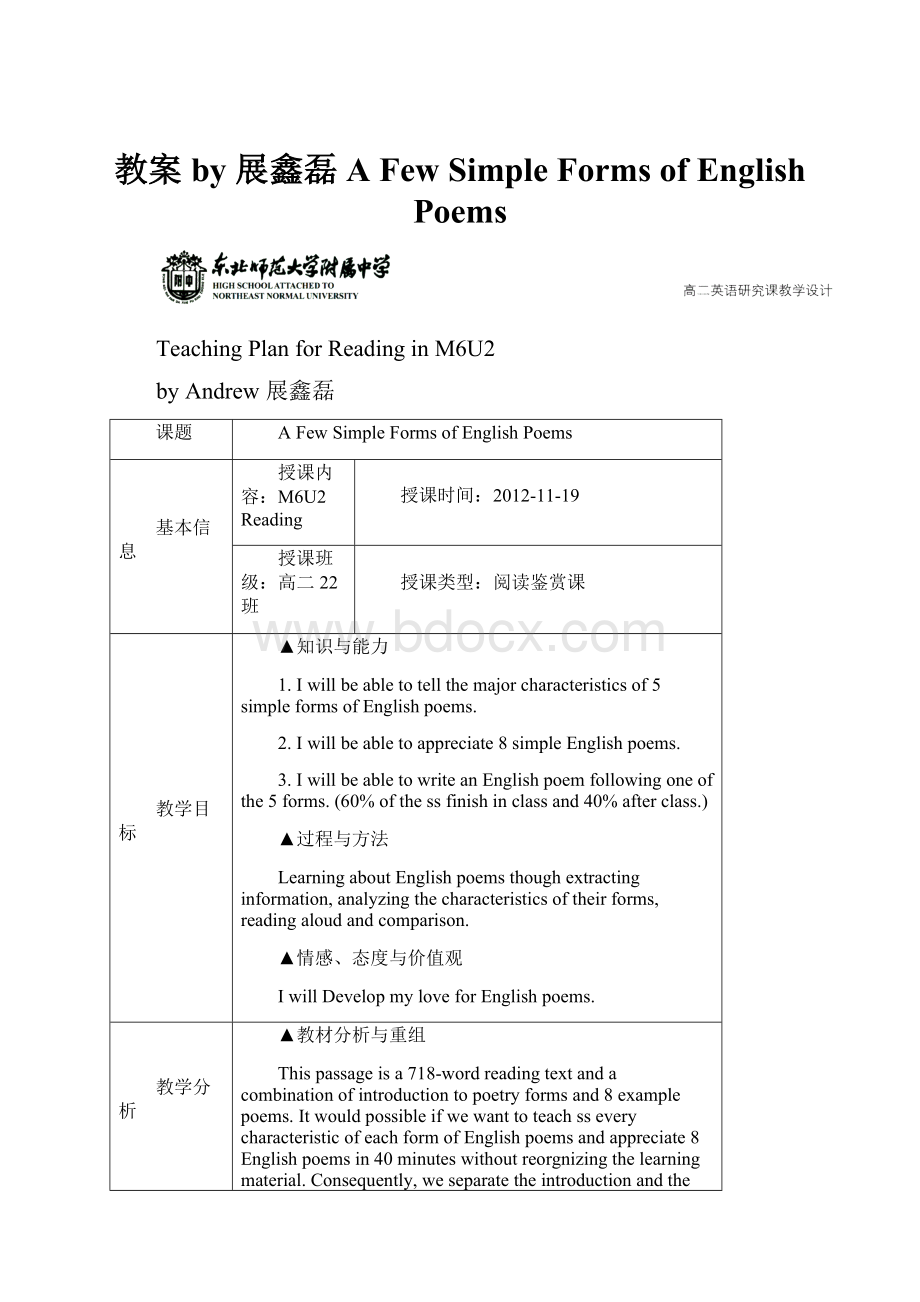教案by 展鑫磊A Few Simple Forms of English Poems.docx
《教案by 展鑫磊A Few Simple Forms of English Poems.docx》由会员分享,可在线阅读,更多相关《教案by 展鑫磊A Few Simple Forms of English Poems.docx(10页珍藏版)》请在冰豆网上搜索。

教案by展鑫磊AFewSimpleFormsofEnglishPoems
TeachingPlanforReadinginM6U2
byAndrew展鑫磊
课题
AFewSimpleFormsofEnglishPoems
基本信息
授课内容:
M6U2Reading
授课时间:
2012-11-19
授课班级:
高二22班
授课类型:
阅读鉴赏课
教学目标
▲知识与能力
1.Iwillbeabletotellthemajorcharacteristicsof5simpleformsofEnglishpoems.
2.Iwillbeabletoappreciate8simpleEnglishpoems.
3.IwillbeabletowriteanEnglishpoemfollowingoneofthe5forms.(60%ofthessfinishinclassand40%afterclass.)
▲过程与方法
LearningaboutEnglishpoemsthoughextractinginformation,analyzingthecharacteristicsoftheirforms,readingaloudandcomparison.
▲情感、态度与价值观
IwillDevelopmyloveforEnglishpoems.
教学分析
▲教材分析与重组
Thispassageisa718-wordreadingtextandacombinationofintroductiontopoetryformsand8examplepoems.ItwouldpossibleifwewanttoteachsseverycharacteristicofeachformofEnglishpoemsandappreciate8Englishpoemsin40minuteswithoutreorgnizingthelearningmaterial.Consequently,weseparatetheintroductionandthepoemsandgeta328-wordtextand8simplepoems(6ofthemareputintoanenvelopeforeachstudentandtheother2asextramaterials.).(SeeAppendix1&2)Besides,weonlyfocusonthemajorcharacteristicsofeachform,thussavetimeinanalyzingthereadingpassage.
▲学生情况分析
Senior2sshavegotbetterskillsinreading.Mostofthemareabletoliterallyappreciateliteratureworks.HardlyhavessreadEnglishpoemsbefore,however,Chinesepoemsarequitefamiliartothem.
▲教学重点
1.Letsstellthemajorcharacteristicsof5simpleformsofEnglishpoems.
2.Helpssunderstandandappreciate8Englishpoems.
▲教学难点
1.Helpthessunderstandwhypeoplesayhaikuisspecial.
2.SswritetheirownEnglishpoemsinclasswithinlimitedtime.
教学过程
Teacher
Students
Comments
1.Lead-in
(2min)
T:
Yesterday,wehavelearnedaboutthebasicknowledgeofEnglishpoemsbycomparingthemwithChineseones.Today,wewilltalkaboutanotherimportantaspectofEnglishpoems.LookattheseChinesepoems.Whatarethedifferencesbetweenthem?
T:
(summarizess’answersinto“form”)Asyouallknow,ChinesePoemshaveavarietyofformstofollow.DoyouthinkthesamethingexistsinEnglishpoems?
T:
(collectss’opinions)Yesorno?
You’llfigureitoutafterthislesson..
ComparethepresentedChinesepoemsandfindoutthedifferences.
Knowwhatwe’regoingtolearnaboutinthislesson.
继续沿用上节Warming-up中使用的中英文诗歌对比学习的方法引导学生发现本课核心内容——英文诗歌的诗体。
2.
FastReading
(4min)
T:
(writethetitle—AFewSimpleFormsofEnglishPoemsdownontheblackboard)Nowyouhavetimetoquicklyglancethroughthispassageandanswerthequestionsonthescreen.Markoutthekeywordsifnecessary.You’vegotonly2minutes,solet’sdoitassoonaspassible.
T(collectss’answers)letsssgetfamiliarwiththenamesofthe5formsofEnglishpoems.
Ssquicklyreadthepassageandmarkouttheanswerstoteacher’squestions.
Ssanswerthequestionstogether.
引导学生略读课文了解大意和结构并标记主要信息。
3.
FocusonNurseryRhymes
(8min)
T:
Nowlet’sfocusonthefirstformofEnglishpoems.Pleasereadtheparagraphaboutnurseryrhymesandfill-intheblanks.AmIclear?
Goahead.
T:
(aftercheckingtheanswers)Whatwehaveputherearejustthemajorcharacteristicsofnurseryrhymes.Openyourenvelopes.Youhave6poemsineachenvelope.Onlyoneofthemisanurseryrhyme.Pleasepickitoutaccordingtothesekeywords!
(PoemD)
T:
WhydoyouthinkDisanurseryrhyme?
Children’spoetry!
Exactly!
Whatabouttheothercharacteristics?
Imean3“R”s.Nowlet’stakeapartofthispoemtothescreenandseeifithasallofthe3“R”s.(Tletsssnoticetherepetition,rhymeandrhythmofthepoem.)The3“R”smakethepoemveryeasytorecite.Buthowcanwereadthemout?
Hereisanexample.(Treadthefirst2linesoutwithbeats.)Let’strythistogether!
(Thewholeclassreadthepoemwithbeats.)Interesting?
Thebeautyofitisfarmorethanthis.Getyourhandsandfeetready!
(followthesong)
Ssrecognizeanurseryrhymeaccordingtothecharacteristicsofnurseryrhymesandappreciatethepoemfromthefollowingperspectives:
repetition,rhymeandrhythm.Ssbetterunderstandthebeautyofthepoembyreadingitoutwithbeatsandsingingit.
指导学生通过阅读提取关键信息,找出童谣这一诗体的主要特征,并能利用这些特征辨认具体诗例。
随后利用学生们发现的诗体特征着重了解例诗的音韵美,并通过打节拍阅读和歌唱的方式进行强化,给学生带来美的体验。
T:
The3“R”smakeapoemasbeautifyassongs.Totellyouthetruth.PoemDisnottheonlyonethathas3“R”s.Wehaveanotherone.Canyoupointitout?
(PoemA)
T:
DoyouthinkPoemAcanalsobereadoutinthesameway.Practicereadingitloudlywithyourneighbours!
Don’tforgettoclapyourhands.(askoneofthestudentstoreadpartofthepoemafterpracticing)
T:
Doyouthinkthe3“R”salsoworkwellinthispoem?
Isthereanyrepetition?
Doseitrhyme?
Is
4.
FocusonListPoems
(4min)
therhythmstrongorweek?
Allofthe3“R”s!
NowIwouldlikeyoutocompareantherpoemwithit.PleasetakeoutPoemB.Comparethe2poemsfromthe3perspectivesandfill-inthe3blankshere.30seconds!
T:
(aftercheckingtheanswers)AlthoughPomeAandBarequitedifferent,theybelongtothesamegroup.Theyarelistpoems.Thereasonwhywecallthemlistpoemsisthatthey...(arelikelistsorlistthings)ThemwhatarelistedinPoemA?
(thethings“I”saw)WhataboutPoemB?
(theexcusesforlosingthegame)
T:
Justnowwe’vecomparedtwolistpoems.Gotabetterunderstanding?
Comparisonisacommonmethodtoappreciatepoems.Wewilluseitagainlater.NowpleasegobacktothereadingpassageandcompleteParagraph3.(checkanswers)
SsfineoutasimilarpoemwithPoemD(bysimilarImeantheybothhavethe3“R”s)andpracticereadingit(PoemA)outinthesameway.SscomparePoemAandBandanalyzethedifferencesandsimilaritiesofthem.
Ssreadbothpoemstogettoknowwhatarelistedinbothpoems.
Sscompletetheintroductiontolistpoemsaccordingtotheirownresultsofthecomparison.
以3R这一特征为切入点帮助学生找到新的例诗,做到自然过渡。
如果说对童谣的处理采取了“从诗体介绍到例诗赏析”的正向处理方式,这步采取的正是“从例诗对比到诗体特征”的反向处理方式。
同时也向学生们渗透了“对比分析法”这一诗歌鉴赏的常用手段。
T:
Mostofthepoemsofthese2formsareasbeautifulassongs.Well,wealsohaveotherformsofpoemsthatareasbeautifulaspaintings?
Nowlet’smoveontocinquain.WhocanreadtheintroductionforcinquaininParagraph4forus.Canyousummarizethecharacteristicsofcinquain?
T:
Nowthatwehaveonly3poemsleft,whichonedoyouthinkisacinquain?
(PoemF)Cinquaindosenothave3“R”s.Howeverwecanstillreaditoutinapoeticway!
Whowouldliketotryit?
T:
(afterss’reading)Asyou’vementioned,cinquainconveysclearpictures.Canyouseeanypictureinthispoem?
Whoisinthepicture?
Who’sbrother?
Whatdoseyoubrotherlooklike?
Howabouthischaracter?
(Orwhatkindofpersondoyouthinkyourbrotheris?
)Howdoyouthinkofyourbrother?
Why?
T:
See,youcangetnotonlyaclearpicturebutalsomuchhiddeninformationfromthispoem.
Ssreadtheparagraphaboutcinquainandsummarizethecharacteristicsofit(conveyspicturesandhasonly5lines).
Ssrecognizeacinquaininthepoems.(PoemF)
Ssdescribethepicturetheycanseefromthepoem.
前两类诗体注重音韵,而接下来的两类诗体注重意象。
教师在此对学生做出欣赏重心转变的指导(从asbeautifulassongs到asbeautifulaspaintings)。
处理方式采取“正向处理”。
作为第2个“正向处理”的段落,本段的阅读任务难度提高了,从填表变为总结。
5.
FocusonCinquain
(6min)
T:
Hereisanothercinquain.Whatisitabout?
Severalwordsaremissing.Let’strytogetthembacktogether.(letssreadouttheirownpoemaftercomposing)
T:
Yousucceededinfillinginthemissingwords.Thatmeansyoualreadybeganthinkingabouttheruleofits5lines.Actually,eachlineofacinquainhasitsowncharacteristics.Lookatthischart.Line1hasonenounandisthesubjectofthepoem?
WhataboutLine2...
T:
The5linesofcinquaingiveusacleardirectiontofollowifwewanttowriteone.What’smore,ithelpsthepoemachieveanotherkindofbeauty.Doyouagree?
Manycreativepoetshavetheirpoemswritteninspecialshapes.Look!
(Presentspictures)Youcanalsohaveatry!
Sstrytocompleteanothercinquainaboutbutterflyandnoticethefeaturesofeachlineofthe5.
Sstrytofill-inthechartaboutthefeaturesofthe5lines.
Ssappreciatethebeautyofpoems’shape.
虽然是画面感强的诗歌,教师仍提醒学生注意朗读(朗读法)的韵味。
追问环节让学生读出诗歌的画面和隐含信息。
同类诗歌的补写为写作埋下伏笔同时提示学生注意五个诗行的特征。
补全表格为学生创作这种诗歌提供有效指导。
特殊形状的诗歌展示扩展学生视野。
7.
FocusonHaiku
(3min)
T:
Youhavejustcompletedapoemaboutbutterfly.Ihavealsopreparedapoemaboutbutterflyforyouinyourenvelopes.Haveyounoticedit?
Whichpoem?
(PoemE)
T:
Let’sreadittogether.(afterreading)Thispoemistypicalhaiku—thefourformwe’regonnalearntoday.Arethereanysimilaritybetweencinquainandhaiku.(conveyclearpictures)
T:
Whatpicturescanyouseeinthispoem?
What’stheconnectionsbetweenabutterflyandafallenblossom?
Doyouthinkit’sspecial?
That’swherehaikuisdifferentfromcinquain.
T:
Anotherexample.Readittogether.Doyouthinitisspecial?
Why?
Hereisamissingwordinthefirstline.It’sawordforoneofthefourseasons.Canyoudecidewhichseason?
Why?
Ssreadtwotypicalpoemsofhaikuandappreciatethepicturesconveyedinthepoems.
Sstrytodiscoverwhypeoplesaythathaikuisspecial.
以“描写对象相同”为入手点切入到俳句这一诗体。
引导学生结合例诗比较两种诗体的相同点(画面感强)和不同点(俳句意象奇特),重点体会俳句诗的奇特意象,并通过为例诗填词的方式检验学生的理解程度。
T:
Doyoulikethisformofpoems?
Solet’sgobacktotheintroduction.Readandfill-intheblanks.(guessthemeaningof“minimum”)
6.
RoughlyAppreciateTangPoems
(3min)
T:
HaikuisnottheonlyAsianformofpoemsthatispopularwithEnglishwriters!
Amorepopularformis...?
(TangPoems)whichistranslatedform....?
(Chinese)
T:
TakeoutPoemCandlisten.(arecord)
T:
Whoknown